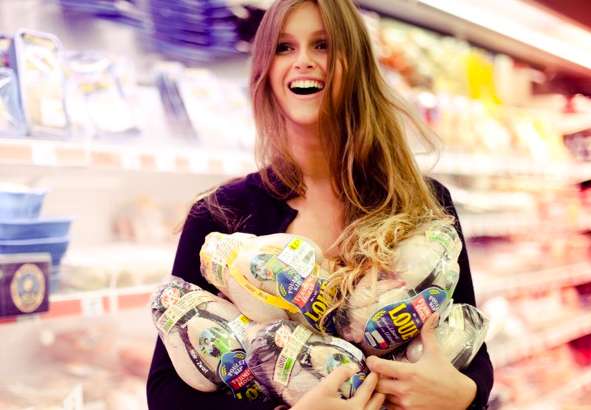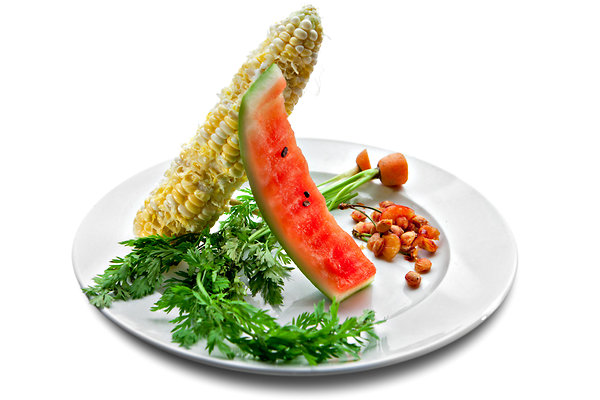Going forward the focus of the climate debate is going to be food. All the experts are saying wars will also be about food in the future. The fact is, we’re fast reaching a point where the planet won’t be able to feed us. And we’re going to be falling over each other to get at resources.
To be honest, I’m kind of glad the debate has come to this. It’s a tangible concept. I’m hoping that as the discussion shifts to food and food warfare, we’ll care more. We’ll wake up. Because we won’t have a choice. We need to eat.

In the US last week a report found that eating healthy has become too expensive for most. It created much discussion over there. Soon it will be the same with junk food.
Anyway, in the meantime, what to do, both from an economic and an ecological POV?
It’s simple and elegant. Waste less.
I’m unashamedly militant about using every last bit of food. And I get incensed when I’m around people who don’t. It’s a pet issue of mine and I don’t hold back.
Some principles I personally live by:
* I don’t buy more until I’ve finished what I already have (in the fridge/pantry). I completely run out of yoghurt before I set out to buy another. That way I find myself then using up the last of the sour cream or cheese in the interim.
* I cook the leaves from beetroot bunches as I would silverbeet (and eat with oil and pepper and salt). Ditto the leaves from cauliflower and broccoli (just don’t do with rhubarb – the leaves are poisonous)
* I don’t peel anything. I eat the rind/skin on pumpkin, potatoes, carrots, beetroot. A lot of the nutrients are contained in the skin.
* Celery leaves – great in soup and salads. I use as I would parsley. I make a pistou using the leaves, too.
* I shop every few days, rather than do a weekly shop. And I shop with a plan for 2-3 meals at a time.
* I cook in batches, using up the whole onion, the whole tin of tomatoes, all the beans. And I freeze what I don’t eat (which is more environmentally sound than storing the stuff in the fridge, anyway).
* If it looks like I won’t be able to eat that whole bunch of silverbeet or the bag of beetroot, I cook the whole lot up as I’m making dinner that night and freeze in zip-lock bags (measured out into serving portions). PS. I always wash and resuse zip-lock bags.
* When my veggies are looking lack-lustre, I make a big soup with lentils and bacon thrown in for flavour and protein. I stab-mix the lot. I juice fruit and beetroots and carrots. Or I make mish-mash meals.
* When I go away, I clean out the fridge. I make my breakfast/lunch etc for the flight using dregs, rather than buy airline/airport food. Again, see my mish-mash meals post for ideas.
* I soak and cook my own beans and pulses (again, in batches and freeze in portions)…super cheap, no cans.
* I don’t put stuff in the fridge I know I won’t get to eating in the 2-3 days before it will go off. Again, I freeze it. Eg: if I open a carton of chicken stock, I pour any excess into icecube trays and use 1-2 cubes to saute vegetables, instead of oil.
That’s all I can think of for now…and I should stop before I sound like a sanctimonious twat.
All of this is timely as the NSW government launches their new Love Food Hate Waste program. Someone from the 1 Million Women campaign alerted me to it.
- NSW households waste about $1,000 of food per household, per year
- 40 per cent of the average household bin is discarded food making food waste the largest single component of our household garbage.
- scraping leftovers into the bin contributes directly to climate change. When food waste is thrown away and sent to landfill, together with other organic materials, it becomes the main contributor to the generation of methane – a greenhouse gas 25 times more potent than carbon dioxide in its impact on climate change. National greenhouse inventory data tells us landfills contribute to two per cent of Australia’s total greenhouse gas emissions.
As part of the the campaign they’re sharing recipes and a serving size calculator and 1 Million Women is encouraging us all to register – you will receive a free menu planner and shopping list notepad.
Their top five tips to help reduce food waste are:
- Plan your weekly meals
- Write a shopping list
- Measure your serving sizes
- Store your food correctly
- Use your leftovers
2010 NSW Australian of the Year John Dee, founder & Managing Director of ‘Do Something!’ and founder of Planet Ark, has alerted me to FoodWise, a national campaign organised by his action group Do Something! The aim of the campaign is to get Australians to reduce the environmental impact of their food consumption.
Now, if you’re ready to go the extra mile, The New York Times ran a story on how to use/eat more of your scraps. Some pretty clever ideas:

CARROT, CELERY AND FENNEL LEAVES Mix small amounts, finely chopped, with parsley as a garnish or in salsa verde: all are in the Umbelliferae family of plants. Taste for bitterness when deciding how much to use.
CHARD OR COLLARD RIBS Simmer the thick stalks in white wine and water with a scrap of lemon peel until tender, then drain and dress with olive oil and coarse salt. Or bake them with cream, stock or both, under a blanket of cheese and buttery crumbs, for a gratin.
CITRUS PEEL Organic thin-skinned peels of tangerines or satsumas can be oven-dried at 200 degrees, then stored to season stews or tomato sauces.
CORN COBS Once the kernels are cut off, simmer the stripped cobs with onions and carrots for a simple stock. Or add them to the broth for corn or clam chowder.
MELON RINDS Cut off the hard outer peels and use crunchy rinds in place of cucumber in salads and cold soups. [I’ve also had candied watermelon rind at a restaurant at some stage…]
PEACH LEAVES Steep in red wine, sugar and Cognac to make a summery peach-bomb aperitif. (According to David Lebovitz’s recipe, the French serve it on ice.)
POTATO PEELS Deep-fry large pieces of peel in 350-degree oil and sprinkle with salt and paprika. This works best with starchy potatoes like russets.
YOUNG ONION TOPS Wash well, coarsely chop and cook briefly in creamy soups or stews, or mix into hot mashed potatoes.
TOMATO LEAVES AND STEMS Steep for 10 minutes in hot soup or tomato sauces to add a pungent garden-scented depth of tomato flavor. Discard leaves after steeping.
TOMATO SCRAPS Place in a sieve set over a bowl, salt well and collect the pale red juices for use in gazpacho, Bloody Marys or risotto.
TURNIP, CAULIFLOWER OR RADISH LEAVES Braise in the same way as (or along with) collards, chards, mustard greens or kale.
WATERMELON SEEDS Roast and salt like pumpkinseeds.
What do you do? What can you share?

